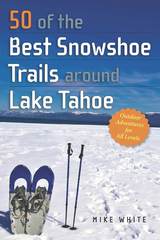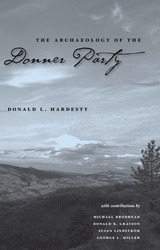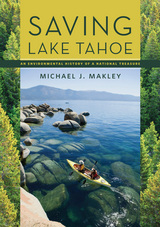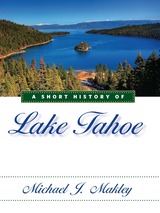
50 of the Best Snowshoe Trails Around Tahoe offers snowshoers of all levels and experience a wide-range of excursions—from flat and easy to steep and strenuous. It includes a wide range of snowshoe routes such as Mt. Rose, Carson Pass, Emerald Bay, Fallen Leaf Lake, Highway 89, Truckee and Donner Pass. Features include:
- Fifty distinct routes with directions to trailheads, detailed trip descriptions, and topographic maps
- Forty-five stunning photographs of popular trails, landscapes, and lake views
- Easy-to-read headings to provide key information on trail difficulty, distance, elevation, avalanche risk, facilities, managing agencies, highlights, lowlights, and more.
- A wide-range of outings for snowshoers of all abilities
- Recommendations on where to grab a hot drink, enjoy a hearty meal, or to snuggle up for a cozy overnight stay
- Tips on everything from proper clothing and footwear, equipment checklists, pre-hike warm-ups, sanitation, dog-friendly trails, and permit requirements
Whether you are an amateur explorer or a winter adventure enthusiast, this comprehensive guidebook has everything you need to explore the winter playgrounds surrounding Lake Tahoe.


Left alone, nature healed itself, and by the 1960s mature forests once again surrounded the lake and its water clarity improved, with visibility more than one hundred feet deep. However, Tahoe’s wonders brought a new kind of threat: millions of annual visitors and incessant development, including ski resorts and casinos. Saving Lake Tahoe looks at the interaction through the years between human activities and Tahoe’s natural ecosystems. It is a dramatic story of ecological disasters and near misses, political successes and failures. Utilizing primary sources and interviews with key figures, Makley provides a meticulously researched account of the battles surrounding the management of the Tahoe basin.
Makley takes the story up to the present, describing the formation and evolution of a new type of governing body, the bistate Tahoe Regional Planning Agency, and groundbreaking efforts to utilize science in establishing policy. He depicts the passionate fights between those who seek to preserve the environment and advocates of individual property rights. Although Tahoe remains unique in its splendor, readers will understand why, with continued pressure for development, reversing environmental deterioration and improving the lake water’s clarity remain elusive goals.

Lake Tahoe is one of the scenic wonders of the American West, a sapphire jewel that attracts millions of visitors each year. But the lake drew Native Americans to its summer shores for millennia, as well as more recent fortune hunters, scientists, and others.
A Short History of Lake Tahoe recounts the long, fascinating history of Lake Tahoe. Author Michael J. Makley examines the geology and natural history of the lake and introduces the people who shaped its history, including the Washoe Indians and such colorful characters as Mark Twain and legendary teamster Hank Monk, and later figures like entertainer Frank Sinatra and Olympic skier Julia Mancuso. He also covers the development of the lake's surrounding valley, including the impacts of mining, logging, and tourism, and the economic, political, and social controversies regarding the use and misuse of the lake's resources.
Generously illustrated with historic photographs, this book is an engaging introduction to one of the most magnificent sites in the world. It also illuminates the challenges of protecting natural beauty and a fragile environment while preserving public access and a viable economy in the surrounding communities.
READERS
Browse our collection.
PUBLISHERS
See BiblioVault's publisher services.
STUDENT SERVICES
Files for college accessibility offices.
UChicago Accessibility Resources
home | accessibility | search | about | contact us
BiblioVault ® 2001 - 2024
The University of Chicago Press









